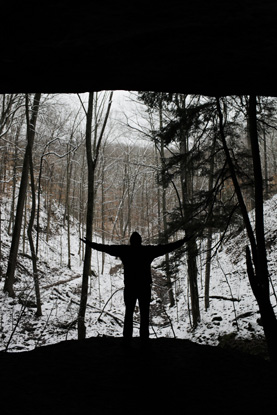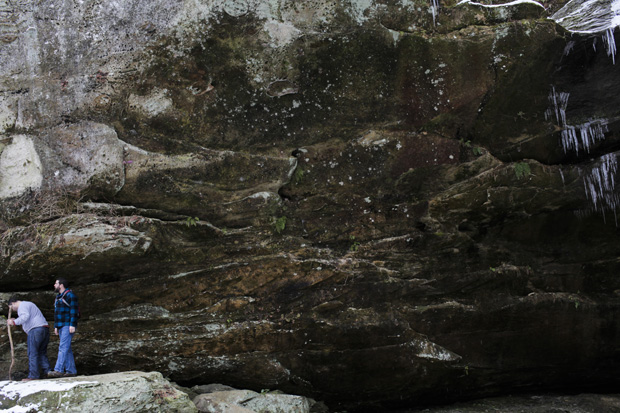Pretty often I meet photo subjects who inspire me, but Jim Harig, a small animal farmer in southern Missouri, made we want to be a better person. Here are a couple select photos from my time with Jim. Please watch the video to learn more about him and why he had such a positive impact on me and read more about the program that helps aging and disabled farmers over at MIZZOU magazine
blog posts
TNT
I like interacting with people. I like taking pictures of people. I like looking at pictures of people. So when I get an assignment that doesn't involve me photographing people, I usually cringe. This was the case when I got an assignment from Illumination magazine to illustrate a story about munitions pollution remediation. The Department of Defense has identified 2,307 contaminated sites (more than 15 million acres) across the country, for which they have no viable plan to clean up. The story was about two researchers at Mizzou who have invented a new cost effective remediation process to clean up TNT and DNT pollution. I had two main obstacles with this assignment. The first was to find a site that was visually appealing. The second and most difficult was to actually gain access to the site. As you can imagine, the DOD was not real receptive to any publicity about these polluted sites. After weeks of dead ends, I finally had a break through and gained access to a site in Weldon Springs, MO.
The Weldon Springs Ordinance Works was the largest manufacturer of TNT and DNT during WWII. Over the course of the war Weldon Springs employed 5,000 people and manufactured millions of tons of explosives. Explosives manufacturing ended shortly after the war, but the site was then used to enrich weapons grade uranium up until the end of The Cold War. In the early 2000's the DOD worked with the EPA to clean up the contaminated site. Everything was burned, leveled and buried, which was the accepted remediation techniques used at the time. Everything except 1,600 acres that remained an Army ROTC training center. The below photographs came from this section of land.
I still don't like getting assignments where I'm not photographing people, but if I do, I hope they are all as visually stimulating as this place was.
The year of the icicle
I visited a hidden gem in Southern Indiana this past weekend. Hemlock Cliffs. A box canyon, nestled in the rolling hills of the Hoosier National Forrest. As I began down the snowy path into the canyon, on what was the last day of 2012, I asked myself what I had been doing the past 12 months. What were my accomplishments? What were my failures? Where was I headed? Where had I been? And as I looked up at the 200 ft. sandstone cliffs, I began to ask them the same questions? When did they reflect on their accomplishments? How did they measure their successes? Climbing on the backs of these gentle giants, as they gracefully dangled the cold, rigid fingers of icicles, I couldn't help but start to feel pretty insignificant. I realized that my expected lifetime isn't even a blip on the map of these gigantic cliffs and trees and streams. I in fact, had more in common with the quickly melting icicles. Here one day and gone the next. A depressing thought, no doubt, but then I began to notice how beautifully unique each icicle was. How brilliantly structured its fragile connection to the cliff side was. Then, I took several steps back and could see hundreds of them at once. At that point I started to understand the silent beauty of these crystal sculptures. Even though they are not here forever, like the cliffside, they majestically hydrate the forrest below during the cold harsh winter. And they do so in such glorious fashion. I then began to realize it was okay to be the icicle and not the cliff. It was okay to be here only a short time, as long as we spend that time doing something beautiful, and meaningful. Something that benefits others. So here's to 2013. The year of the icicle.
20121231_Hemlock-Cliffs01
20121231_Hemlock-Cliffs02
20121231_Hemlock-Cliffs04
20121231_Hemlock-Cliffs03
20121231_Hemlock-Cliffs05
20121231_Hemlock-Cliffs06
20121231_Hemlock-Cliffs07
20121231_Hemlock-Cliffs08
20121231_Hemlock-Cliffs09
20121231_Hemlock-Cliffs10
20121231_Hemlock-Cliffs11
Put your f@%#ing shoes on
This post is about selective memory. The photographs below depict the quiet, happy moments that occur between the countless stubborn stand off's, power-struggles and never ending rounds of 20 questions that make up a day in the life of my three year old son. Whoever came up with the idea of "terrible two's," must have killed their child well before they reached the age of three. Now maybe I'm dramatizing just a little, but Cohen can be a real asshole. I have literally been late to work on several occasions simply because Cohen didn't want to put on his shoes. I mean really, your not going to wear shoes? In the words of Walter Sobchack, "Cohen, this is not Vietnam, there are rules." But for every moment of contention and self absorption, there is an equally selfless and affectionate moment that balances out this delicate familial equation. So, instead of posting pictures of tantrums, tears and broken down baby gates (which I have), I have used selective memory to show off the quiet, beautiful moments I get to share with the most important person I know. Plus, I don't think Tana would appreciate the call from Child Protective Services wondering why Cohen is always screaming bloody murder.
Tana and Cohen in the front yard.
Cohen and Tana rocking
Tana and Cohen in the front yard.
Tana and Cohen in the front yard.
Tana and Cohen in the front yard.
Cohen sitting at the table
runaway
I worked on a story this spring about a troubled teen who, with the help of her family and therapist, got on the right track. Below is a selection of photos and a small story I photographed and wrote for Illumination magazine. The longer article about multisystemic therapy can be found here on the Illumination website. During a ten-month period when she was 14, Kayla Cody ran away from home more than 20 times. “We were in shock,” says her father, Dennis Cody. “We just kept asking ourselves what we did wrong to make her go down that path.” Cody, now 17, disappeared for weeks at a time, sometimes staying with friends and, at one point, spending an entire week sleeping in a car. “Running was scary, but it was the only thing I had,” says Cody. “If it would have continued, I would have ended up in a juvenile home.”
After seeing a family counselor with little success, Cody’s family turned to Rheagan Fernandez, a multi-systemic therapist working at Places for People, a mental health services provider in St. Louis. It didn’t take long for Fernandez to figure out the problem — a lack of communication. Today, thanks to six months of therapy and work with the Missouri Option Program — a Department of Elementary and Secondary Education initiative that allows students to make up missed credits — Kayla is on schedule to graduate with her class. “Kayla is still Kayla. She has a little attitude but knows what she has to do now to succeed,” says her father.

































